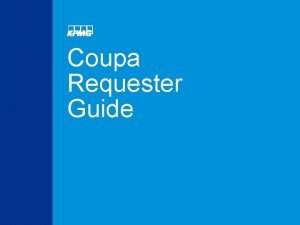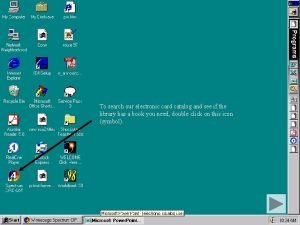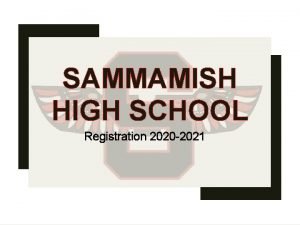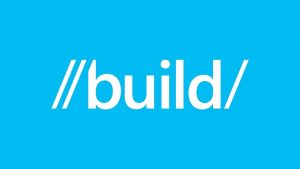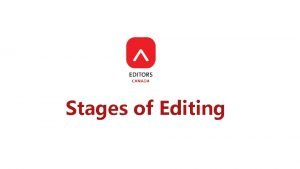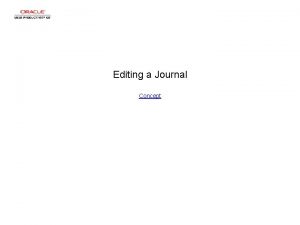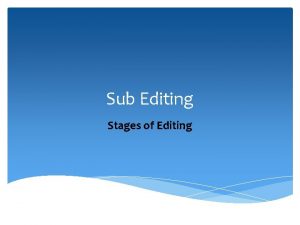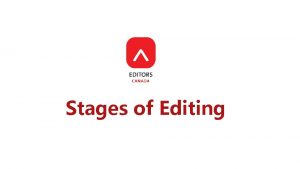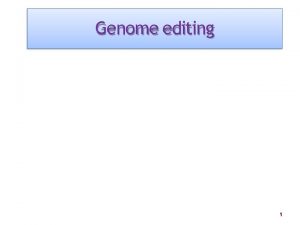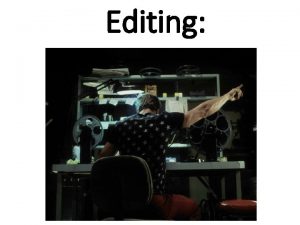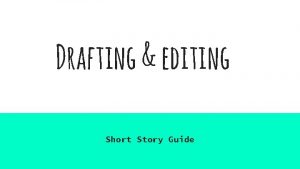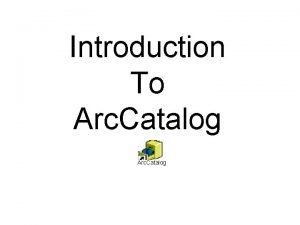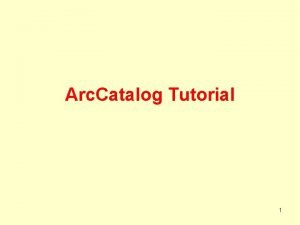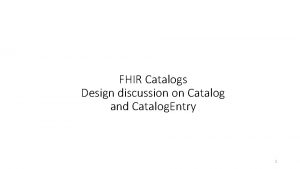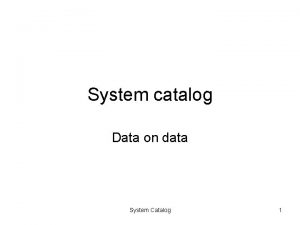COURSELEAF CATALOG EDITING GUIDE COURSELEAF CATALOG EDITING GUIDE





























- Slides: 29

COURSELEAF CATALOG EDITING GUIDE

COURSELEAF CATALOG EDITING GUIDE

IMPORTANCE OF THE CATALOG • The catalog of the University is the document of authority for all students. • All academic policies and student requirements must be included.

CAT OVERVIEW FOR PAGE OWNERS • Overview • Page Body Editor • Help Bubbles • Links • Tables • Course Lists • Plan of Study Grids • Footnotes • Start Workflow • Additional Resources SAMPLE URL@tulane. edu

ACCESSING THE CATALOG • Accessing the catalog • https: //nextcatalog. tulane. edu/ • Enter your Tulane Credentials • Chrome and Firefox are preferred browsers. • Navigate to a page you own. • Click on Programs or Schools to open up the catalog content. • All users can view the entire catalog while in editing mode but only edit pages assigned to them.

NAVIGATION • There are three ways to navigate through the catalog • The Nav Bar • Will expand depending on the page to show relationship to other areas in the catalog • Breadcrumb Trail • The bread crumbs are another way to show relationship to rest of catalog by showing the path taken to get there • Allows you to click back to a previous area of the catalog • Search Box • Site. Search is the search engine for Course. Leaf CAT. It allows Course. Leaf to direct users to preferred pages by using keywords. Pages that are set up with keywords appear at the top of the search results, allowing Course. Leaf to more directly influence search results.

HOW TO OPEN A PAGE FOR EDITING • To edit a page, click on the Edit Page put in the top left hand corner.

TOOLBARS

TOOLBARS • Accuracy Report • Will identify any errors found on page • Courses not found in Banner • Course information doesn’t match what is in Banner • Show Differences • If any text was deleted and replaced with new text, the old text will still be visible in red with strike through. The new text will be displayed in green • View as PDF • Allows user to export copy of catalog page without unnecessary features on the webpage

PRINT OPTIONS • Users have the ability to download and print the entire catalog, or individuals pages. • Click Print Options

COURSE BUBBLES • Students read the catalog to find about courses. • Course bubbles pull directly from Banner. • If course description need to be updated, please send the information to the Registrar’s Office to update in Banner.

HELP BUBBLES • Every page in the catalog has a help bubble. • This button will direct you to tutorials and step by step instructions related to the task you are currently working on. • As a Course. Leaf user, you are also eligible to attend webinars scheduled through Lilypad University. • https: //help. courseleaf. com/addt-resources/lilypadu/

PAGE BODY EDITOR • Required Tabs • Schools • Departments • Academic Policies • Degree Requirements • Departments • Programs • Overview- Information about program and why a student would be interested • Requirements- ALL requirements to complete the major and/or earn degree. ***Hyperlinking any of this information to websites outside of the catalog is not acceptable.

PAGE BODY EDITOR • To edit the overview, click Edit “Page Body”

PAGE BODY EDITOR (CONT. ) • • Styling tools Paragraph alignment List and bullet icons Headers • Start at H 2. If using subheadings, continue with H 3, then H 4, and so forth.

PAGE BODY EDITOR (CONT. ) • If copying text, paste into Notepad to remove any formatting before using paste feature. • Don’t forget about the Help Bubble!

SAVING • You can save two ways: • Click to Save button in the toolbar • Click Ok.

HOW TO CREATE LINKS • Open the toolbar • Open the page body editor for the page you want to work on • Highlight the text or image that is desired to be turned into a hypertext link • Click the Insert/Edit Link button • Type the destination web address into the text box labeled URL • To link to a website or another page outside of the catalog, simply type http: //somepage. com. For example: http: //google. com • For links to pages within the catalog, use the relative url by entering the portion of the URL following. com or. edu. For example, to link to this page a user would enter: /cat/page-body/links • To open the link in a new window, click the check box next to Open in a New Window • Click OK on the Page Body Editor to save your changes

HOW TO LINK TO AN EMAIL ADDRESS • Open the toolbar • Open the page body editor for the page you want to work on • Highlight the text or image that is desired to be turned into a hypertext link • Click the Insert/Edit Link button • Type mailto: into the text box labeled URL • Immediately following mailto: type the email address with no spaces. For example, mailto: department@tulane. edu • Click OK on the Page Body Editor to save your changes • Note: Using a mailto: link will open a blank email addressed to the linked address in the user’s default mail client when the user clicks the hyperlink

INLINE COURSE • Click Edit Page • Click Page Body or the pencil icon corresponding to the tab on which you want to insert the inline course • Click Insert/Edit Database Field or press Ctrl+D (as to link the course code back to the source • Type in the Course or select the school and subject. Click Ok • Note: If the course code does not link back to the source, a red box will appear around the course. Check to make sure the correct course code has been entered which may be case and/or spacing sensitive.

COURSE LISTS • Click on Edit Requirements • If a course lists exists, double click inside blue area to open to begin editing. • To create a course list, click on Insert Formatted Table. Select Course List. Press Ok. • Begin selecting courses by choosing School/subject or the Quick Add field. • Click >> to move to course list. Click << to move out. Note- If you indent courses, the credits will not sum.

COMMENT ENTRY • To make headers or separate groups of requirements, click Add Comment Entry • To Bold, click Area Header. • Move up or down in course list with arrows.

PLAN OF STUDY • Click Edit Page • Open the page body editor • Place cursor in page body where you would like to insert the Plan of Study Grid in the Page Body • Click Insert/Edit Formatted Table • Select Plan of Study Grid from the drop down menu • Enter the course information. Begin with Year 1 and desired Term. • Click OK to save your table • Click OK to save your changes

FOOTNOTES • • • Create a course list or plan grid or open the table editor Click on the course that should have the indicator Enter the indicator in the footnote field Click OK to save the table Click OK to save the page

FOOTNOTES • • • Place cursor in the page body where the footnote table is to be placed Click Insert/Edit Formatted Table Select Footnotes from the drop-down menu and click OK In the Footnotes editor, click New Footnote. Enter the footnote symbol Enter the footnote content Repeat to add more footnotes as necessary Click OK to save the table Click OK to save the page

START WORKFLOW Press The Green Button To Send The Page For Approval (bottom right).

ADDITIONAL RESOURCES • https: //help. courseleaf. com/cat/ • https: //registrar. tulane. edu/faculty-staff-resources

https: //registrar. tulane. edu/

 K8s service catalog
K8s service catalog Courseleaf api
Courseleaf api Data preparation process in research methodology
Data preparation process in research methodology Linear and nonlinear editing
Linear and nonlinear editing Coupa invoice inbox
Coupa invoice inbox Ponte vedra high school course catalog
Ponte vedra high school course catalog Gonzaga course catalog
Gonzaga course catalog Texas health steps
Texas health steps Klein course selection
Klein course selection Harbor college child development center
Harbor college child development center Curriculum and catalog management
Curriculum and catalog management Advertising subscription mixed revenue model
Advertising subscription mixed revenue model Ordine materii catalog
Ordine materii catalog Colorado pdis
Colorado pdis Catalog enrichment
Catalog enrichment Ocls catalog
Ocls catalog Catalog poems
Catalog poems Ability one source
Ability one source Electronic card catalog
Electronic card catalog Interlake high school course catalog
Interlake high school course catalog Apache data catalog
Apache data catalog Mtda course catalog
Mtda course catalog Magda data catalog
Magda data catalog Cmul opac
Cmul opac Sammamish high school counselors
Sammamish high school counselors Catalog poem generator
Catalog poem generator Interlake high school course catalog
Interlake high school course catalog Unc charlotte course catalog
Unc charlotte course catalog Milwaukee county catalog
Milwaukee county catalog Azure data catalog use cases
Azure data catalog use cases




